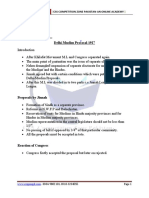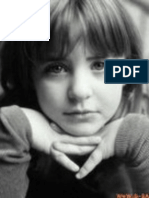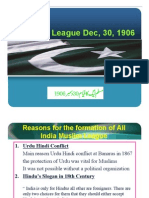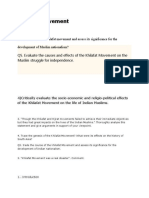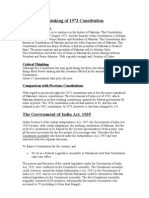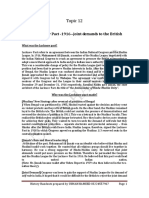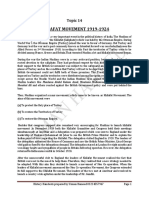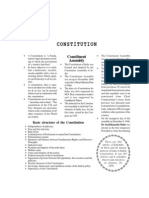Hist Topic 23 General Elections 1945 1946 Plan 2 PDF
Hist Topic 23 General Elections 1945 1946 Plan 2 PDF
Uploaded by
abubakarCopyright:
Available Formats
Hist Topic 23 General Elections 1945 1946 Plan 2 PDF
Hist Topic 23 General Elections 1945 1946 Plan 2 PDF
Uploaded by
abubakarOriginal Title
Copyright
Available Formats
Share this document
Did you find this document useful?
Is this content inappropriate?
Copyright:
Available Formats
Hist Topic 23 General Elections 1945 1946 Plan 2 PDF
Hist Topic 23 General Elections 1945 1946 Plan 2 PDF
Uploaded by
abubakarCopyright:
Available Formats
Topic 23
GENERAL ELECTIONS 1945- 1946
After the failure of Simla conference Lord Wavell announced general and
provincial elections after which constitutional making body was to be set up.
Both parties launched election campaigns. Because they knew that the
elections were essential for the future of India, as the results were to play an
important role in determining their standing.
The League wanted to sweep the Muslim constituencies so as to prove that
they were the sole representatives of the Muslims of India, while on the other
hand Congress wanted to prove that they represent all Indians. Both parties
raised different slogans during whole election campaign. Congress tried to
get support of all those parties who were against the Muslim League.
Elections for central legislature were held on December 1945 with the limited
franchise. During these elections Congress won about 80 percent of the
general seats and 91.3 percent general votes and Muslim League won all 30
reserved seats for Muslims. Provincial election held on 1946 results was not
different. Muslim League won 95 percent seats for Muslims and Congress
won all seats for non-Muslims.
CABINET MISSION PLAN 1946
In March 1946, a three man delegation including Lord Pethic
Lawrence (secretary of state for India) sir Stafford Cripps (president of
the board of trade) and A.V Alexander (first lord of the admiralty) was
sent to India to try to find a settlement acceptable to all.
They arrived in New Delhi on 24 March 1946.
The cabinet mission proposed that an interim government should be
set up & the government would form an All-India commission from
members of the provincial & central legislatures.
In 1946 the cabinet mission announced its final plan.
Proposals of the cabinet mission plan:
It rejected the idea of establishing Pakistan.
Three different parts suggested to a post British India.
(a) The Hindu majority territories.
History Handouts Prepared by Usman Hameed 03224557967 Page 1
(b) The western Muslim population
(c) Bengal & Assam
Each part would have its local autonomy & would be able to draw up
its new constitution.
Foreign affairs, defense & communication would be managed by a
central Indian union.
League stated that it was ready to nominate members to an interim
cabinet to oversee the move to independence by this plan.
Nehru said that congress would not feel bounded by the plan after
British left so the plan dropped.
DIRECT ACTION DAY 1946:
Direct Action Day, also known as the Great Calcutta Riot, was on 16
August 1946—a day of widespread riot and manslaughter in the city of
Calcutta (now known as Kolkata) in the Bengal province of British India. The
day also marked the start of what is known as "The Week of the Long
Knives".
The protest triggered massive riots in Calcutta, instigated by the Muslim
League and its Volunteer Corps against Hindus and Sikhs, followed by
retaliatory attacks on Muslims by Congress followers and supporters. In
Calcutta, within 72 hours, more than 4,000 people lost their lives and
100,000 residents in the city of Calcutta were left homeless. Violence in
Calcutta sparked off further religious riots in the surrounding regions of
Noakhali, Bihar, United Province (modern Uttar Pradesh), Punjab, and the
North Western Frontier Province. These events sowed the seeds for the
eventual Partition of India.
THE 3RD JUNE PLAN 1947
When all of Mountbatten's efforts to keep India united failed, he asked Ismay to
chalk out a plan for the transfer of power and the division of the country. It was
decided that none of the Indian parties would view it before the plan was finalized.
The plan was finalized in the Governor's Conference in April 1947, and was then sent
to Britain in May where the British Government approved it.
However, before the announcement of the plan, Nehru who was staying with
Mountbatten as a guest in his residence at Simla, had a look at the plan and rejected
it. Mountbatten then asked V. P. Menon, the only Indian in his personal staff, to
present a new plan for the transfer of power. Nehru edited Menon's formula and
then Mountbatten himself took the new plan to London, where he got it approved
without any alteration. Attlee and his cabinet gave the approval in a meeting that
lasted not more than five minutes. In this way, the plan that was to decide the future
History Handouts Prepared by Usman Hameed 03224557967 Page 2
of the Indo-Pak Sub-continent was actually authored by a Congress-minded Hindu
and was approved by Nehru himself.
Mountbatten came back from London on May 31, and on June 2 met seven Indian
leaders. These were Nehru, Patel, Kriplalani, Quaid-i-Azam, Liaquat, Nishtar and
Baldev Singh. After these leaders approved the plan, Mountbatten discussed it with
Gandhi and convinced him that it was the best plan under the circumstances. The
plan was made public on June 3, and is thus known as the June 3rd Plan.
Proposals of the 3rd June plan;
Two states should be set up India & Pakistan.
The interim government of both states was the 1935 government of
India act.
Each state was to have dominion status & have an executive
responsible to a constituent assembly.
Muslim majority provinces would vote either to stay in India or join
Pakistan. In Sindh & Baluchistan, provincial Legislatures voted to join
Pakistan. Bengal & Punjab decided that they should join Pakistan but
their Muslim – minority areas will remain in India. NWFP also joined
Pakistan after holding a referendum. The Muslim-majority district of
Sylhet in Assam joined the eastern wing of Pakistan.
(a) Day after a 3rd June plan, Mountbatten said that final transfer of
Power might be brought forward from June 1948 to 15 August
1947.
(b) On 15 July 1947 the independence Act was passed.
(c) From 15 august British India would be partitioned into two
Dominion states.
THE RADCLIFFE BOUNDARY AWARD 1947:
SIR Cyril Radcliff was appointed to head a Boundary Commission to
establish new borders.
Radcliff had four assistants, two nominated by the league & two by
the congress.
The decision of the Boundary Commission known as “the Boundary
Award or Radcliff Award” was announced on 16 August 1947.
Calcutta, Gurdaspur, Ferozpur were awarded to India though they
were Muslim majority areas.
Jinnah told people of Pakistan that the awards were wrong, unjust &
perverse.
History Handouts Prepared by Usman Hameed 03224557967 Page 3
SECTION III
ACHIEVEMENT OF QUAID-E-AZAM
As aleader:
He was the 1st governor general of Pakistan.
He was an inspiration for the nation.
He took the role of Chief Executive in the new government & chaired
the cabinet meetings.
He was the president of the constituent assembly.
Building a Nation:
Jinnah dealt with the problems faced by Pakistan at the time of
partition.
Country was divided into east & West Pakistan & he coup with the
geographical problems as well.
Jnnah stressed everyone to work together to create nation.
He said: “every one of us should think, feel & act as Pakistani & we all
should be proud on being Pakistanis alone.
Jinnah was opposed to religious intolerance, provincialism & racialism.
He called himself as the protector general of religious minorities.
He was determined to see Pakistan a land of tolerance.
He said that Islamic ideas about justice & equality demanded that any
non Muslim who was to remain in Pakistan should be treated fairly.
Jinnah helped refugees by setting up a relief fund to rehabilitate them.
He secured the membership of the country to UNO in September 1947.
Building a government:
Quaid knew that no problem could be solved until the country had
an administration that could take decision about the problems.
Liaqat ali khan was made the prime minister & a cabinet was
formed. A constituent assembly was also set up.
Karachi became the capital of Pakistan.
Central secretariat was setup to run the country.
Civil service was reorganized & civil rules were drafted.
Quaid was determined that government officials should have right
attitude to their work.
He informed the officials that they were the servants of people &
not the rulers of the country. He wanted them to work with national
spirit.
Building an economy:
Pakistan was denied its full share of wealth.
History Handouts Prepared by Usman Hameed 03224557967 Page 4
It was difficult to convert Pakistan from an agricultural country to one
with a degree of industrial development.
On 1st July 1948, Quaid established State bank of Pakistan to help
develop the economy.
Quaid reached a compromise with India in the canal water dispute,
which ensured that Pakistan’s Agriculture would not be denied precious
water supplies.
He also urged to set up industries in Pakistan.
Establishing national security:
Pakistan had been given poor military equipment & it lacked senior
cadre officers for army.
Army needed more officers.
Quaid didn’t want Pakistan become a military oligarchy.
Conclusion:
Quaid died on 11 September 1948.
Times news paper wrote. “No succeeding GG can quite fill his place as
the Father of the Nation”.
Stanley Walport said, “Few individuals significantly alter the
course of history, still very few change the map of the world,
hardly anyone can be credited with creating a nation state,
Mohammad Ali Jinnah did three”.
Expected questions:
Question No. 1: which of the following contributed the most to the establishment of a
separate homeland for Muslims.
(i) Gandhi Jinnah talks 1944
(ii) Simla conference 1945
(iii) Cabinet mission plan 1946
Explain your answer with reference to all three of the above. 14
Nov 2002, Q.3 c
Question No. 2: How important was Mohammad Ali Jinnah to the Pakistan movement?
Explain your answer. 14
Nov 2001. Q. 3 c
Question No. 3: what was the Direct Action Day? 4
June 2010 Q.3 a
History Handouts Prepared by Usman Hameed 03224557967 Page 5
You might also like
- Nehru ReportDocument3 pagesNehru Reportpari100% (4)
- Pak Studies History in 50 Pages by Furqan Mushtaq Wih Proper ImagesDocument72 pagesPak Studies History in 50 Pages by Furqan Mushtaq Wih Proper ImagesHamza Khalid67% (3)
- 3rd June PlanDocument3 pages3rd June Plansabir17100% (3)
- Two Nation TheoryDocument2 pagesTwo Nation TheoryRaja100% (5)
- Democracy in Pakistan: Crises, Conflicts and Hope for a ChangeFrom EverandDemocracy in Pakistan: Crises, Conflicts and Hope for a ChangeRating: 5 out of 5 stars5/5 (3)
- Political Events From 1940 To 1947Document3 pagesPolitical Events From 1940 To 1947MAWiskiller50% (6)
- Cabinet MissionDocument5 pagesCabinet Missionjawad hanif100% (1)
- Pakistan Movement 1940 To 1947Document8 pagesPakistan Movement 1940 To 1947KARIMA IFTIKHAR100% (2)
- Lahore Resolution AssignmentDocument3 pagesLahore Resolution AssignmentMark Manson100% (2)
- Initial Problems of PakistanDocument3 pagesInitial Problems of PakistanRimsha100% (1)
- 3 June Plan (1947) : Raj Muhammad KhanDocument9 pages3 June Plan (1947) : Raj Muhammad KhanAbbas Babar100% (1)
- Lahore Resolution 1940Document31 pagesLahore Resolution 1940omairabbas4075% (8)
- The Lucknow Pact 1916Document11 pagesThe Lucknow Pact 1916House of knowledge100% (1)
- Constitution of Pakistan, 1973Document14 pagesConstitution of Pakistan, 1973Saftah Rehman100% (2)
- Radcliff Award 1947Document4 pagesRadcliff Award 1947Moin Satti100% (1)
- The Third June PlanDocument1 pageThe Third June PlanTheWriters LarkanaNo ratings yet
- Objective ResolutionDocument2 pagesObjective ResolutionBiya100% (1)
- All India Muslim LeagueDocument3 pagesAll India Muslim Leaguejaved rashidNo ratings yet
- HIS103, L-7, Lahore Resolution (1940)Document17 pagesHIS103, L-7, Lahore Resolution (1940)Samiun Mazumder Chayan100% (1)
- Initial Problems of Pakistan 1947 48 2 PDFDocument7 pagesInitial Problems of Pakistan 1947 48 2 PDFobaidNo ratings yet
- Mujadad Alf e SaniDocument5 pagesMujadad Alf e SaniHamza WaheedNo ratings yet
- Lahore Resolution 1940Document14 pagesLahore Resolution 1940MZCHOHANNo ratings yet
- Ideology of Pakistan With Reference To Allama Muhammad Iqbal World NotesDocument6 pagesIdeology of Pakistan With Reference To Allama Muhammad Iqbal World NotesNaimatullah Ullah100% (1)
- One Unit SchemeDocument1 pageOne Unit Schemesidra khanNo ratings yet
- Government of India Act 1919 - The Montague Chelmsford Reforms History IIDocument2 pagesGovernment of India Act 1919 - The Montague Chelmsford Reforms History IIDinesh Gadkari100% (1)
- 6 - Delhi Muslim Proposal - 1927Document1 page6 - Delhi Muslim Proposal - 1927fahadraja7889% (9)
- Shimla DeputationDocument2 pagesShimla DeputationAleeha Ilyas50% (2)
- Cabinet MissionDocument7 pagesCabinet Missionxandercage100% (1)
- Initial Problems of PakistanDocument25 pagesInitial Problems of PakistanGhulam Mohi UddinNo ratings yet
- Pakistan Peoples Party AssignmentDocument36 pagesPakistan Peoples Party AssignmentChotoo Sparkle100% (8)
- The Era of General ZiaDocument5 pagesThe Era of General ZiaRashid AmeerNo ratings yet
- Lahore Resolution Pakistan Studies (2059)Document6 pagesLahore Resolution Pakistan Studies (2059)emaz kareem StudentNo ratings yet
- Why Muslim League Was Brought in To Existence Explain Objectives of The Muslim LeagueDocument3 pagesWhy Muslim League Was Brought in To Existence Explain Objectives of The Muslim LeagueArslan Nazir100% (1)
- Institute of Communication Studies Bs (Hons) 2 Semester Pakistan StudiesDocument20 pagesInstitute of Communication Studies Bs (Hons) 2 Semester Pakistan StudiesSyed Sohaib Zubair100% (1)
- Lecture 6 - Partition of Bengal, Its Annulment and Its Impact On Hindu-Muslim RelationsDocument20 pagesLecture 6 - Partition of Bengal, Its Annulment and Its Impact On Hindu-Muslim RelationsSazzad Hossain SakibNo ratings yet
- All India Muslim LeagueDocument23 pagesAll India Muslim LeagueMalik Ammar Asad93% (14)
- Lahore Resolution 1940Document2 pagesLahore Resolution 1940MZCHOHAN100% (1)
- Quaid e Azem As Governor GernalDocument3 pagesQuaid e Azem As Governor GernalMúhámmáD Táríqúé RáhóóJó100% (2)
- Yahya KhanDocument17 pagesYahya KhanHassun CheemaNo ratings yet
- What Is Two Nation TheoryDocument20 pagesWhat Is Two Nation TheoryShafi MuhammadNo ratings yet
- HIST TOPIC 25 Early Years 1947 To 1958 PDFDocument3 pagesHIST TOPIC 25 Early Years 1947 To 1958 PDFabubakar100% (1)
- Darul Uloo Nadwa 2Document3 pagesDarul Uloo Nadwa 2Mushtak MuftiNo ratings yet
- The Constitutional Evolution in Pakistan (1947-1956)Document9 pagesThe Constitutional Evolution in Pakistan (1947-1956)zaheer abbas100% (2)
- ALLAMA IQBAL's Presidential Address December 1930Document3 pagesALLAMA IQBAL's Presidential Address December 1930Mohd MuneerNo ratings yet
- Sir Syed Ahmed KhanDocument22 pagesSir Syed Ahmed Khanprince12No ratings yet
- Urdu-Hindi Conflict: Hindi and Nagri Scripts in The Government Offices and CourtDocument2 pagesUrdu-Hindi Conflict: Hindi and Nagri Scripts in The Government Offices and CourtAnum100% (1)
- Creation of Pakistan and Role of Quaid-e-Azam (Dr. Atif Aftab)Document19 pagesCreation of Pakistan and Role of Quaid-e-Azam (Dr. Atif Aftab)abdul waleedNo ratings yet
- Ayub Khan EraDocument12 pagesAyub Khan Eraizza ghafoor100% (2)
- CSS/PMS ANSWERS On Khilafat MovementDocument66 pagesCSS/PMS ANSWERS On Khilafat MovementSayed Adnan ShahNo ratings yet
- Lfo 1970Document2 pagesLfo 1970Noor e IlmNo ratings yet
- The Radcliffe Award PDFDocument7 pagesThe Radcliffe Award PDFAshwath SitaramanNo ratings yet
- Six Points Movement: Background & AftermathDocument22 pagesSix Points Movement: Background & Aftermathabdullah islamNo ratings yet
- 1937 ElectionsDocument13 pages1937 ElectionsHamza Khan100% (1)
- Assignment of Constitution 1973 (Software Eng, Part-1) Dated 20-04-2008Document12 pagesAssignment of Constitution 1973 (Software Eng, Part-1) Dated 20-04-2008Athar Hassan Panhwar100% (1)
- Simon Commission Notes PDFDocument7 pagesSimon Commission Notes PDFHamna100% (1)
- Pakistan ResolutionDocument2 pagesPakistan Resolutionusmanklodhi100% (1)
- Aboard the Democracy Train: A Journey through Pakistan's Last Decade of DemocracyFrom EverandAboard the Democracy Train: A Journey through Pakistan's Last Decade of DemocracyRating: 5 out of 5 stars5/5 (1)
- Hist Topic 23 General Elections 1945 1946 Plan 1Document5 pagesHist Topic 23 General Elections 1945 1946 Plan 1Hamna RazaNo ratings yet
- 5 The British Plan of The Partition of The Punjab in 1947Document26 pages5 The British Plan of The Partition of The Punjab in 1947Mohammad Waqas SaramNo ratings yet
- 1.making of PakistanDocument20 pages1.making of PakistanRayan IsranNo ratings yet
- Chapter 9: Finding A Solution To The Problems Between 1940-1947Document20 pagesChapter 9: Finding A Solution To The Problems Between 1940-1947Edu TainmentNo ratings yet
- Hist Topic 24 Initial Problems of Pakistan 1947 48 2 PDFDocument7 pagesHist Topic 24 Initial Problems of Pakistan 1947 48 2 PDFabubakarNo ratings yet
- Hist Topic 21 The Gandhi Jinnah Talks 1944 PDFDocument2 pagesHist Topic 21 The Gandhi Jinnah Talks 1944 PDFabubakar100% (1)
- HIST TOPIC 26 Field Marshal Mohammad Ayub Khan 1958 To 1969 PDFDocument5 pagesHIST TOPIC 26 Field Marshal Mohammad Ayub Khan 1958 To 1969 PDFabubakarNo ratings yet
- Hist Topic 28 Zulfikar Ali Bhutto PDFDocument5 pagesHist Topic 28 Zulfikar Ali Bhutto PDFabubakarNo ratings yet
- Hist Topic 31 Benazir Bhutto and Nawaz Sharif 1988 To 1999 PDFDocument6 pagesHist Topic 31 Benazir Bhutto and Nawaz Sharif 1988 To 1999 PDFabubakarNo ratings yet
- HIST TOPIC 30 General Zia Ul Haq 1977 1988 PDFDocument5 pagesHIST TOPIC 30 General Zia Ul Haq 1977 1988 PDFabubakar100% (1)
- Hist Topic 22 Lord Wavell The Simla Conference 1945 PDFDocument3 pagesHist Topic 22 Lord Wavell The Simla Conference 1945 PDFabubakar100% (1)
- Hist Topic 23 General Elections 1945 1946 Plan 2 PDFDocument5 pagesHist Topic 23 General Elections 1945 1946 Plan 2 PDFabubakarNo ratings yet
- Hist Topic 20 Cripps Mission 1942 PDFDocument4 pagesHist Topic 20 Cripps Mission 1942 PDFabubakarNo ratings yet
- HIST TOPIC 25 Early Years 1947 To 1958 PDFDocument3 pagesHIST TOPIC 25 Early Years 1947 To 1958 PDFabubakar100% (1)
- HIST TOPIC 18 Congress Rule Day of Deliverance 1937 39 PDFDocument3 pagesHIST TOPIC 18 Congress Rule Day of Deliverance 1937 39 PDFabubakarNo ratings yet
- Hist Topic 24 Initial Problems of Pakistan 1947 48 2 PDFDocument7 pagesHist Topic 24 Initial Problems of Pakistan 1947 48 2 PDFabubakarNo ratings yet
- HIST TOPIC 12 The Lucknow Pact 1916 Joint Demands To The British PDFDocument3 pagesHIST TOPIC 12 The Lucknow Pact 1916 Joint Demands To The British PDFabubakarNo ratings yet
- HIST TOPIC 19 The Pakistan Resolution 1940 PDFDocument4 pagesHIST TOPIC 19 The Pakistan Resolution 1940 PDFabubakarNo ratings yet
- HIST TOPIC 17 The Government of India Act 1935 PDFDocument2 pagesHIST TOPIC 17 The Government of India Act 1935 PDFabubakarNo ratings yet
- Hist Topic 16 The Round Table Conferences PDFDocument5 pagesHist Topic 16 The Round Table Conferences PDFabubakarNo ratings yet
- Hist Topic 16 The Round Table Conferences PDFDocument5 pagesHist Topic 16 The Round Table Conferences PDFabubakarNo ratings yet
- Hist Topic 14 Khilafat Movement 1919 1924 PDFDocument5 pagesHist Topic 14 Khilafat Movement 1919 1924 PDFabubakarNo ratings yet
- HIST TOPIC 13 The Montague Chelmsford Reforms PDFDocument2 pagesHIST TOPIC 13 The Montague Chelmsford Reforms PDFabubakarNo ratings yet
- Hist Topic 15 Simon Commission Nehru Report 14 Points of Jinnah PDFDocument5 pagesHist Topic 15 Simon Commission Nehru Report 14 Points of Jinnah PDFabubakarNo ratings yet
- HIST TOPIC 11 Minto Morley Reforms Indian Council Act 1909 PDFDocument3 pagesHIST TOPIC 11 Minto Morley Reforms Indian Council Act 1909 PDFabubakarNo ratings yet
- Hist Topic 10 Simla Deputation and Muslim League 1906 PDFDocument3 pagesHist Topic 10 Simla Deputation and Muslim League 1906 PDFabubakarNo ratings yet
- History Project 2ND SemesterDocument36 pagesHistory Project 2ND SemesterAshirbad Sahoo100% (1)
- Indian ConstitutionDocument43 pagesIndian ConstitutionRahul Rana67% (3)
- Important Notes of 9th Class Pak Study Chapter 2 English MediumDocument38 pagesImportant Notes of 9th Class Pak Study Chapter 2 English MediumShahrukh UsmanNo ratings yet
- Indian History Full PDF (Corrected)Document15 pagesIndian History Full PDF (Corrected)piyakanphoenix100% (1)
- UPSC Planner 2025- Rishav Sharma.xlsxDocument25 pagesUPSC Planner 2025- Rishav Sharma.xlsxLakshay bhai BhaiNo ratings yet
- Pak Affair 1930 To 1947Document5 pagesPak Affair 1930 To 1947Sher Gull HisbaniNo ratings yet
- HIS103, L-8, Indian Independence Act 1947Document14 pagesHIS103, L-8, Indian Independence Act 1947Samiun Mazumder ChayanNo ratings yet
- Constitutional HistoryDocument17 pagesConstitutional HistoryVanshika GuptaNo ratings yet
- Yasmin Khan - The Great Partition - The Making of India and Pakistan, New Edition-Yale University Press (2017)Document324 pagesYasmin Khan - The Great Partition - The Making of India and Pakistan, New Edition-Yale University Press (2017)ismailzubair139No ratings yet
- Forms of Collective ViolenceDocument204 pagesForms of Collective Violenceaksharma74No ratings yet
- Muktibahini Wins Victory - Maj Gen ATM Abdul Wahab 365pDocument365 pagesMuktibahini Wins Victory - Maj Gen ATM Abdul Wahab 365pMSKCNo ratings yet
- Jawaharlal Nehru BiographyDocument31 pagesJawaharlal Nehru Biographyabhi.c78504No ratings yet
- 5 The British Plan of The Partition of The Punjab in 1947Document26 pages5 The British Plan of The Partition of The Punjab in 1947Mohammad Waqas SaramNo ratings yet
- Political Development From 1937Document6 pagesPolitical Development From 1937usman soomroNo ratings yet
- From (Sachin Nayak (Nliusachin@gmail - Com) ) - ID (833) - HISTORY-IIDocument14 pagesFrom (Sachin Nayak (Nliusachin@gmail - Com) ) - ID (833) - HISTORY-IIMukesh TomarNo ratings yet
- Modern History 43 - Daily Class Notes (Abhishek Srivastav Sir) - (Prahar (UPSC 2023) )Document14 pagesModern History 43 - Daily Class Notes (Abhishek Srivastav Sir) - (Prahar (UPSC 2023) )amit0200016351No ratings yet
- V4i2 8Document21 pagesV4i2 8Mohammad AliNo ratings yet
- Quaid e Azam Muhamed Ali JinnahDocument63 pagesQuaid e Azam Muhamed Ali JinnahTehmina MalikNo ratings yet
- Class Assignment:: Modern HistoryDocument8 pagesClass Assignment:: Modern HistoryNikshay HansNo ratings yet
- MIH AppendicesDocument44 pagesMIH Appendicesabhilashpatel895No ratings yet
- 'Flawed' Argument Gandhi Had Minimal Role, NavalDocument2 pages'Flawed' Argument Gandhi Had Minimal Role, Navalprabhu chand alluriNo ratings yet
- ICSE Class 10 History 2003Document6 pagesICSE Class 10 History 2003Adnan KhanNo ratings yet
- MediaDocument256 pagesMediaAmrit SahooNo ratings yet
- Full download Decolonisation The British Experience since 1945 2nd Edition Nicholas White pdf docxDocument61 pagesFull download Decolonisation The British Experience since 1945 2nd Edition Nicholas White pdf docxbordasferron100% (2)
- 53 Constitutional Crisis of Pakistan A Historical StudyDocument11 pages53 Constitutional Crisis of Pakistan A Historical Studyshahzadaqasim378No ratings yet
- I Humbly Acknowledge Some Answers of A Person. I Don't Know Who He Is But Credit To Him As WellDocument32 pagesI Humbly Acknowledge Some Answers of A Person. I Don't Know Who He Is But Credit To Him As WellGulraiz BalochNo ratings yet
- Cabinet Mission ProposalsDocument2 pagesCabinet Mission ProposalscreamsonNo ratings yet
- 06 - Chapter 1 PDFDocument37 pages06 - Chapter 1 PDFVishal RaiNo ratings yet
- Making of The Constitution NotesDocument3 pagesMaking of The Constitution NotesSri Krishna Bharadwaj GodavariNo ratings yet

























